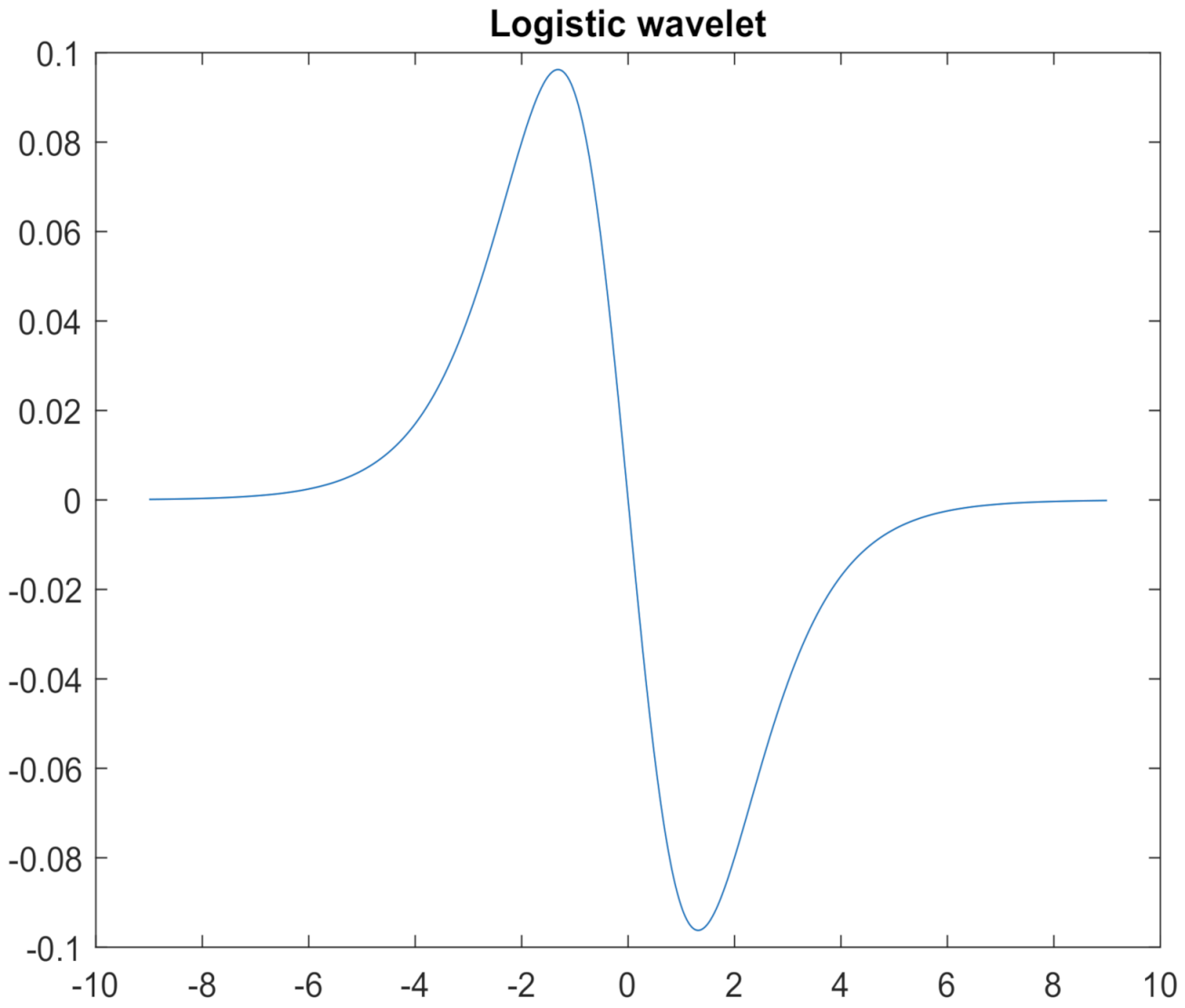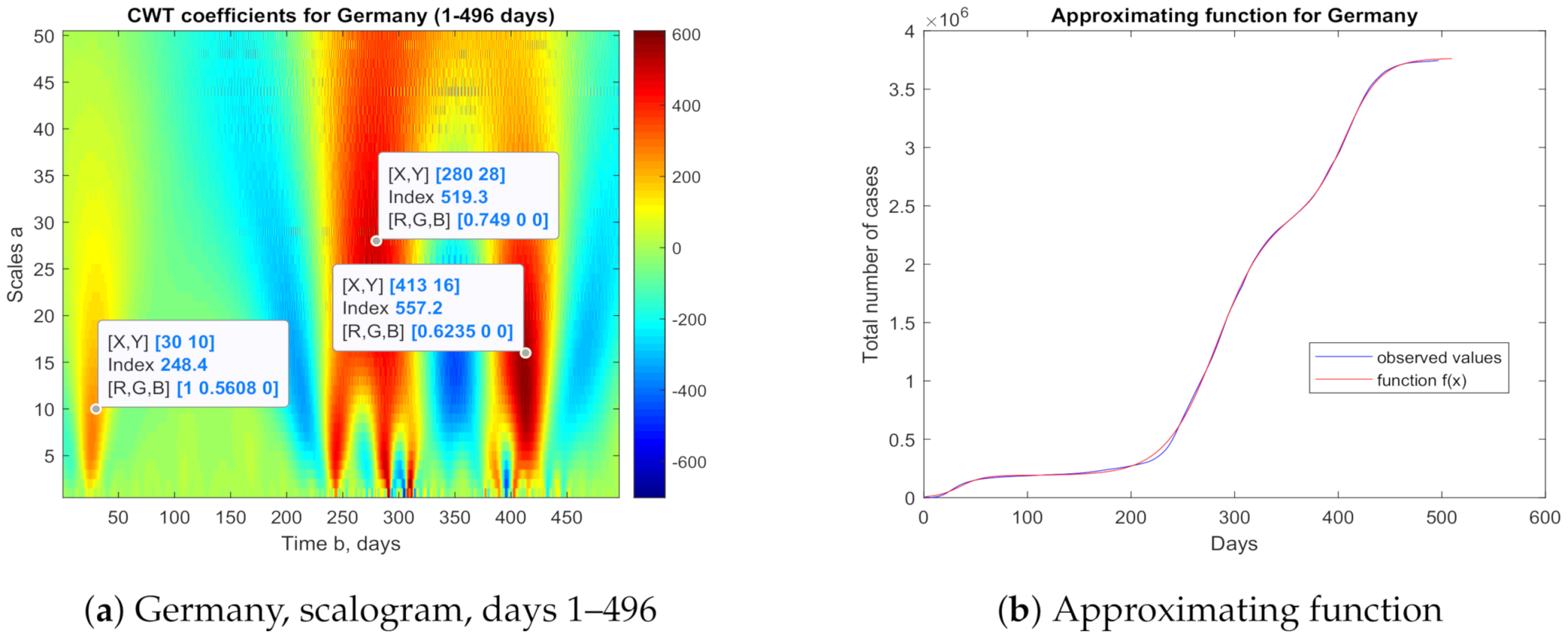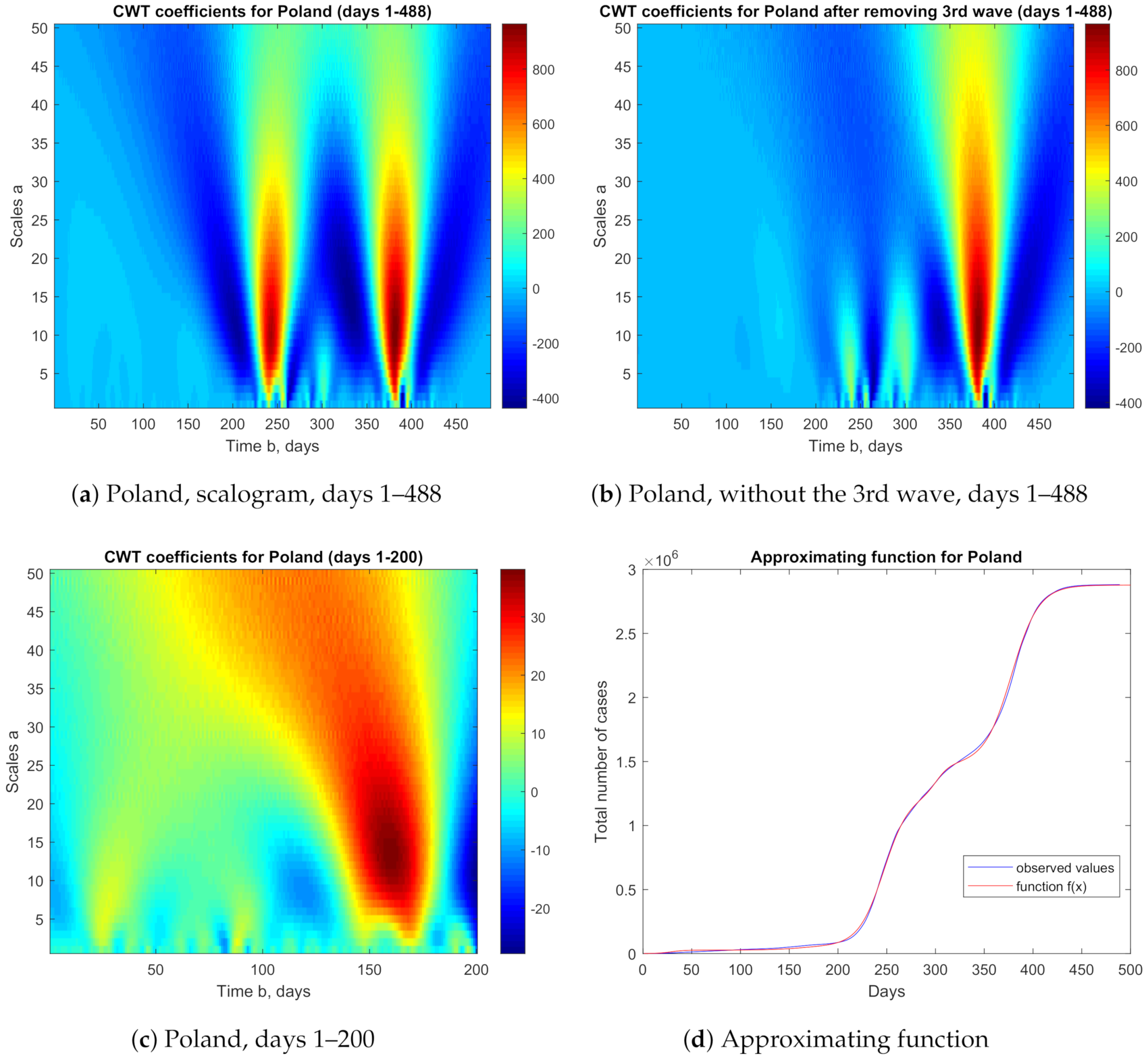1. Introduction
The logistic equation is defined as
where
t is time,
is the unknown function and the parameters
s-steepness and
-saturation level are constants. The integral curve
fulfilling condition
is known as the logistic function.
After solving (
1) we obtain the logistic function in the form
where
is the inflection point, which is related to the initial condition
, therefore
. Putting
in (
2) we see that
.
The logistic function finds applications in many fields, including biology, biomathematics, chemistry, demography, economics, physics, probability, sociology, statistics, and artificial neural networks. The logistic function and the logistic equation, as well as some of their generalizations, have also been widely used in epidemiology to describe various phenomena with a sigmoid trend (see for example papers by Kartono et al. [
1] and Pelinovsky et al. [
2], and the references therein). Fokas et al. [
3] used a generalization of the logistic function for forecasting the number of individuals reported to be infected with COVID-19 in different countries.
Wavelet analysis is now frequently used to extract information from epidemiological and other time series. Grenfell et al. [
4] introduced wavelet analysis for characterizing non-stationary epidemiological time series. Cazelles et al. [
5] used the Morlet wavelets for applications in epidemiology. Krantz et al. [
6] proposed a two-phase procedure (combining discrete graphs and Meyer wavelets) for constructing true COVID-19 epidemic growth. Jose and Bishop [
7] used the reverse biorthogonal wavelet pairs for modeling the rotavirus epidemic dynamics. They also mentioned that they obtained similar results when using the Haar wavelet. Wang et al. [
8] apply the Daubechies wavelet (db2) and the Coiflets wavelet (coif1) for modeling of pertussis incidence in China from 2004 to 2018. Santos et al. [
9] and Zhang et al. [
10] use the wavelet analysis to investigate the correlation between the incidence of dengue and weather conditions. Liu [
11] applies the Haar wavelet transform and the simplex forecasting method to the dataset of hepatitis A in the United States to give predictions of its incidence.
Lavrova et al. [
12] modeled the disease dynamics caused by Mycobacterium tuberculosis in Russia using a sum of two logistic functions (
2) (so-called bi-logistic model). Similar method was used by E. Vanucci and L. Vanucci [
13] for predicting the end date of COVID-19 disease in Italy.
From a slightly broader point of view, the logistic Equation (
1) can be considered in the context of the following non-linear first-order autonomous differential equation
where
is a real, continuous function of
u, representing a non-linear part of the equation. Several exact forms for
have been studied by Tsoularis [
14] and by Tsoularis and Wallace [
15]. An advanced theory with important applications of Equation (
3) is provided by Kowalski and Steeb [
16]. The connections with Lie algebra, Bose–Einstein state, and quantum theory, are put there in evidence.
The method of separated variables gives a first stage of the solution of (
3) in terms of
. This function is explicit only if the integral of the reciprocal of
is exactly available. The second stage of the solution depends on if
can be inverted in a closed form. Most of the important equations are not exactly solvable in terms of
and we need to solve them with numerical integration and inversion.
The functional inversion can be performed with the Lagrange inversion method for some particular forms of
and with a general procedure described in a paper by Dominici [
17] through recursive application of nested derivatives on the kernel
. The result is expressed in terms of the Taylor expansions of
at a given point. One of the authors (GF) of the present paper is preparing a new efficient inversion technique based on an auxiliary exact function and through the fast direct derivative of
followed by a linear triangular recursive inversion algorithm. In his method, the nested derivatives are not necessary.
In the present paper, we introduce logistic wavelets and describe their properties in terms of Eulerian numbers. We add the second logistic wavelet into Matlab’s Wavelet Toolbox, to be able to use the continuous wavelet transform (CWT). We then perform CWT analysis for the second differences of a smoothed total number of people reported as infected with the COVID-19 virus. We model the total number of people infected with the COVID-19 virus by the sum of several logistic functions (the so-called multilogistic function). The CWT analysis allows to estimate parameters of the successive logistic waves, which together form the multilogistic function. All three parameters (i.e., the inflection point, the steepness and the saturation level) of each logistic function can be read from the CWT scalograms. Then we use the non-linear generalized reduced gradient method, minimizing the RMSE error, to optimize the parameters, mainly the saturation levels. To show the accuracy and effectiveness of our method, we apply it to the cases of COVID-19 infection in several countries, as well as around the world. This method, in addition to the curve-fit property to existing data, has also a predictive value, and, in particular, allows for an early assessment of the size of the emerging new wave of the epidemic. Thus it can be used as an early warning method.
This paper is organized as follows. In
Section 2.1, we discuss basic properties of Riccati’s equation, logistic equation, and logistic curve. For this purpose, we use Eulerian numbers.
Section 2.2 and
Section 2.3 are devoted to introduction and study of the logistic wavelets. In
Section 3 we model the cumulative number of persons reported to be infected by COVID-19 in several countries and also in the whole world. The results are discussed and concluded in
Section 4.
We use the following convention for the Fourier transform:
where
(the intersection of the space of integrable functions and the space of square integrable functions defined on the set of real numbers
).
3. Results
We model the cumulative number of persons reported to be infected by COVID-19 virus, using a sum of logistic functions (multilogistic function) of the form
where
k is the number of all considered logistic waves.
Denote by
the total cumulative number of individuals reported to be infected up to
nth day in a country or a region and by
the 7-day moving arithmetic average for the sequence
, i.e.,
We will look, in the sequence
, for points (days
n) corresponding to zeros of the second or the third derivative of the logistic function. This is equivalent to detect points, where the sequence of second differences,
takes a value close to zero or a maximum, respectively.
In order to calculate the continuous wavelet transform (CWT) coefficients for , we implemented into Matlab’s Wavelet Toolbox giving the following definition of the Logistic wavelet:
function [psi,t] = logist(LB,UB,N,∼)
% LOGISTIC Logistic wavelet.
% [PSI,T] = LOGIST(LB,UB,N) returns values of
% the Logistic wavelet on an N point regular
% grid in the interval [LB,UB].
% Output arguments are the wavelet function PSI
% computed on the grid T.
% This wavelet has [-7 7] as effective support.
% See also WAVEINFO.
% Compute values of the Logistic wavelet.
t = linspace(LB,UB,N); % wavelet support.
psi = (exp(- 2* t)-exp(-t))./(1+exp(-t)).3;
end
Observations show that successive, relatively large, logistic waves arise at fairly long time intervals. Therefore, usually, the second differences corresponding to all previous waves are small as the next wave unfolds. However, the largest wave (with relatively high values of both the saturation level
and the parameter
a), may be an exception. Therefore, at least for some countries, we perform the next wavelet analysis and calculate the CWT coefficients after subtracting the largest wave. Hence, we calculate the second differences and perform their wavelet analysis for the following new time series
where for
, the parameters
correspond to the largest wave in (
20). Moreover, if necessary, we also carry out the wavelet analysis for shorter periods of time.
We find the above mentioned points and parameters either directly by observing the sequence of second differences
or read them from the scalograms of the CWT transform of Matlab’s Wavelet Toolbox by using the Logistic wavelet. From the considerations in
Section 2.1 and from (
9) it follows that parameter
b should be determined as that point where the sequence
changes sign. Parameter
a should be chosen in such a way that the distance between the zero and the maximum of
was approximately
(see (
9)). Thus, we obtain two parameters defining a logistic function approximating the time series
. It remains to determine the third parameter of the wave, i.e., its saturation level
u. Assuming that
follows locally a logistic function
and since by definition it holds
then by (
12) we get successively
Using (
21) we can estimate the saturation level
as follows
Parameters
a and
b in (
20) can also be estimated by maximizing locally the integral (i.e., the CWT coefficient) on the left-hand side of (
21). Hence, we find in the sequence
the best pattern corresponding to the wavelet
. The saturation level of a logistic wave can also be estimated as twice the value of the sequence
at the point where
changes signs (inflection point) or its maximal value multiplied by
(zero of the third derivative). This approach is especially important for the last wave of the multilogistic function (
20), when it is still in its initial or middle stage and has not yet terminated. After this we use the non-linear generalized reduced gradient method, minimizing the RMSE error, to optimize the parameters, mainly saturation levels. All data were collected from the Our World in Data website [
27].
We will use the theory to build models for the total cumulative number of individuals reported to be infected by COVID-19 successively in Germany, Italy, Poland, the United Kingdom, the United States, and in the world.
3.1. Germany
Using the example of Germany, we will show in detail the steps leading to the approximating function
(
23). We analyze the data over a period of 496 days from 7 March 2020 (
) to 15 July 2021 (
). On the scalogram (
Figure 2a) showing CWT coefficients, we can distinguish three large logistic waves. We read for them initially (before optimization) the values of parameters
a and
b, as well as the value of the CWT coefficient (i.e., the integral (
21)). Then, we calculate their estimated saturation levels using Formula (
22). We have:
First wave,
. Thus, we estimate the saturation level as follows:
Second wave, 2,306,883;
Third wave, 1,069,440.
Next, we optimize the values of these parameters by minimizing the root mean square error (RMSE) value, which gives:
with the following approximating function
The approximating function
(
23) is shown in
Figure 2b. In the case of Germany, no large, newly emerging logistic wave is visible at that time.
3.2. Italy
In the case of Italy, we analyzed a period of 502 days from 1 March 2020 (
) to 15 July 2021 (
) and obtained the following approximating function
with the error
12,926.
Figure 3 shows scalograms with CWT coefficients and the approximating function (
24).
3.3. Poland
We analyzed data over a period of 488 days from 15 March 2020 (
) to 15 July 2021 (
). The multilogistic approximating function has the following form
with the error
13,433.
Figure 4 shows scalograms with CWT coefficients and the approximating function (
25).
3.4. The United Kingdom
For the UK we analyze the period of 491 days from 12 March 2020 (
) to 15 July 2021 (
).
Figure 5 shows scalograms with CWT coefficients.
In this case, unlike in previous countries, a new, developing logistic wave is visible on the right in the
Figure 5b,c. On July 16 (day 492), this wave has not yet reached its inflection point, as shown by the second differences, which are all positive (
Table 2).
With the CWT analysis alone, it would be difficult to determine the parameters of this wave. However, in order to do it we can use the results of
Section 2.1. Assuming that the second differences reach their maximum on July 14 (day 490), i.e., it is the zero (
) of the third derivative of the last wave, we can estimate its saturation level. Subtracting from
5,142,864 the saturation levels of all previous four waves, we get about 700,000 cases. Thus, the saturation level of the last wave can be estimated as
700,000/0.211 ≈ 3,300,000. Moreover, assuming that the parameter
a is similar to that which was for the other waves, say
, by (
9) we have
. After the optimization we get the following approximating function
with the error
12,174.
Figure 5 shows also the approximating function (
26).
In
Table 3 (Added in proof), we compare the 10-day forecast with actual data. The last two columns show the forecast error, both absolute and relative. It can be seen that the function
predicts the trend quite well for a short period. However, it seems more important that the discussed method can be used for early warning of the appearance of new waves. This is in line with Hu et al. [
28] comments on the use of wavelet analysis to study the development of infectious diseases.
3.5. The United States
In the case of the US, we analyzed the data over a period of 490 days from 13 March 2020 (
) to 15 July 2021 (
). The multilogistic approximating function has the following form
with the error
59,106.
The scalograms with CWT coefficients and the approximating function (
27) are shown in
Figure 6.
3.6. The World
In the case of the whole world, we analyzed the data over a period of 530 days from 2 February 2020 (
) to 15 July 2021 (
). The multilogistic approximating function has the following form
with the error
248,525.
The scalograms with CWT coefficients and the approximating function (
28) are shown in
Figure 7.
4. Discussion
The article deals with the application of the logistic function to the description of phenomena that follow many overlapping sigmoidal trends. We used some properties of the zeros of successive derivatives of the logistic function, in particular their relation to the saturation level.
By using the Eulerian numbers, we defined logistic wavelets of any order and examined their properties, checking for them the general admissibility condition for wavelets. We have added a second order logistic wavelet to the Matlab’s Wavelet Toolbox. Then we performed a wavelet analysis of the time series, whose terms are the second differences of the smoothed total number of individuals infected with the COVID-19 virus in several countries. As a result, we obtained the continuous wavelet transform (CWT) scalograms, from which we could read the distribution of successive logistic waves, and their parameters. Note that the three-dimensional CWT scalograms allow the simultaneous identification of all three parameters of consecutive logistic waves. This has been described in detail using the example of Germany
Section 3.1. Other approximation methods do not provide such possibilities. We then optimized the parameters (mainly the saturation levels) minimizing the RMSE error. We have shown in the examples that the multilogistic function, obtained in this way, well approximates the total number of infections. The theory and procedure can be applied to model the total number of infections in any country or a region.
We limited ourselves to identifying the largest logistic waves visible on the scalograms. There are also visible smaller waves, which we have omitted, because they do not contribute much to the explanation of the phenomenon. These could be considered in addition and then the RMSE error would probably be smaller.
The CWT analysis described above makes it possible to estimate the parameters of the logistic waves that have already terminated. In the case of an ongoing, new wave, what we have seen on the example of the UK
Section 3.4, we should determine its level of development. In practice, it can be done by determining whether the logistic wave has already reached the inflection point (zero of the second derivative, 50% of the saturation level), which corresponds to a change in the sign in the series of second differences
. If the inflection point has not yet been reached, we can try to determine whether the wave has reached the previously located zero of the third derivative. This corresponds to a maximum in a series of second differences (this point is about 21% of the saturation level).
It may be considered in a further work, whether the CWT analysis, based on the use of only the positive part of the second-order logistic wavelet, would be helpful in determining the parameters of ongoing waves.
In our further work, we intend to use, in a similar way, the logistic wavelets of higher order (see
Section 2.3). Moreover, using appropriate special numbers we are going to define analogous wavelets for the Gompertz function (see some initial calculations [
29,
30]) or for some generalizations of the logistic function (for preliminary theorems see [
31]).













